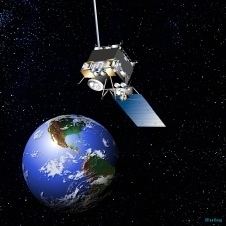Mission type Weather satellite COSPAR ID 2006-018A Website goes.gsfc.nasa.gov Inclination 0.2° Inclination 0.2° Rocket Delta IV | Operator NOAA / NASA SATCAT no. 29155 Mission duration 10 years Power 2.3 kW Launch date 24 May 2006 Manufacturer Boeing | |
 | ||
Similar GOES 15, GOES 12, GOES 14, GOES 11, GOES‑16 | ||
Tropical storm bill formation noaa nasa goes 13 satellite video
GOES 13, known as GOES-N before becoming operational, is an American weather satellite which forms part of the US National Oceanic and Atmospheric Administration's Geostationary Operational Environmental Satellite system. On April 14, 2010, GOES-13 became the operational weather satellite for GOES-EAST.
Contents
- Tropical storm bill formation noaa nasa goes 13 satellite video
- Launch
- Spacecraft
- Operations
- Anomalies
- References
Launch
GOES-N was launched aboard a Boeing Delta IV-M+(4,2) rocket, flying from Space Launch Complex 37B at the Cape Canaveral Air Force Station. The launch occurred at 22:11:00 GMT on 24 May 2006.
The launch had been delayed significantly due to a number of issues. First, it had been scheduled to fly on a Delta III, but after three consecutive failures on its first three flights, the Delta III was cancelled, with GOES launches being transferred to the Delta IV. Further delays were caused after the previous Delta IV launch, the maiden flight of the Heavy configuration, suffered a partial failure. Then, two launch attempts in August 2005 were scrubbed, the second attempt just four minutes and twenty six seconds prior to liftoff.
After these launch attempts, the rocket's flight termination system batteries expired, requiring replacement. A strike by workers at Boeing subsequently pushed the launch back to May 2006.
Spacecraft
At launch, the satellite had a mass of 3,133 kilograms (6,907 lb), and an expected operational lifespan of ten years, although it carries fuel for longer. It was built by Boeing, based on the BSS-601 satellite bus, and was the first of three GOES-N series satellites to be launched. It is currently in a geostationary orbit at a longitude of 75° West.
Operations
GOES-13 has been serving actively as GOES-East since April 2010. In December 2007, it was called up to provide coverage of the east coast of the United States during an outage of GOES 12 due to a thruster leak. After the problem with GOES 12 cleared, it resumed operations, and GOES 13 was deactivated again. It was also briefly activated in mid May 2009, when GOES 12 developed another thruster problem, however it did not need to take over operations, and was deactivated by the end of the month. In April 2010, GOES-13 replaced GOES-12 as GOES-East at 75° West.
Anomalies
In December 2006 GOES-13 observed a solar flare so intense it damaged its Solar X-ray Imager (SXI).
On September 12, 2012, GOES 13 began to return images with an excessive amount of noise. The noise gradually increased to the point at which the satellite was placed in standby mode on September 24 in order to allow engineers to diagnose the problem. GOES 15 temporarily provided backup imagery for a short time, with GOES 14 being taken out of in-orbit storage and prepared to be a longer-term replacement including movement towards the 75 degree slot normally occupied by GOES East. GOES 13 returned to normal operations on October 18, 2012. GOES 14 was kept in normal operations and used to monitor Superstorm Sandy in parallel with GOES 13 before GOES 14 returned to standby status.
GOES 13 unexpectedly suffered an anomaly at 03:40 UTC on May 22, 2013 which left it unable to return weather data. GOES 14 was again activated, taking over GOES-East operations at 06:00 UTC on May 23, however it currently remains at its storage position at 105 degrees West. GOES 13 was scheduled to return to operational status at 15:45 UTC on June 6, 2013 However that was delayed due to a Critical Weather Day and Tropical Storm Andrea.
On 20 November, 2015, at 0922 UTC, the GOES-13 Sounder experienced an anomaly. GOES Engineers determined that the Filter Wheel had stopped moving (the filter wheel aligns the infrared detectors with the incoming data) so data were not scanned. All 18 infrared channels are affected; the visible channel (band 19) continues sending usable data. The filter wheel remains stuck, and GOES 13's sounder products remain unavailable as of 21 February, 2017.
